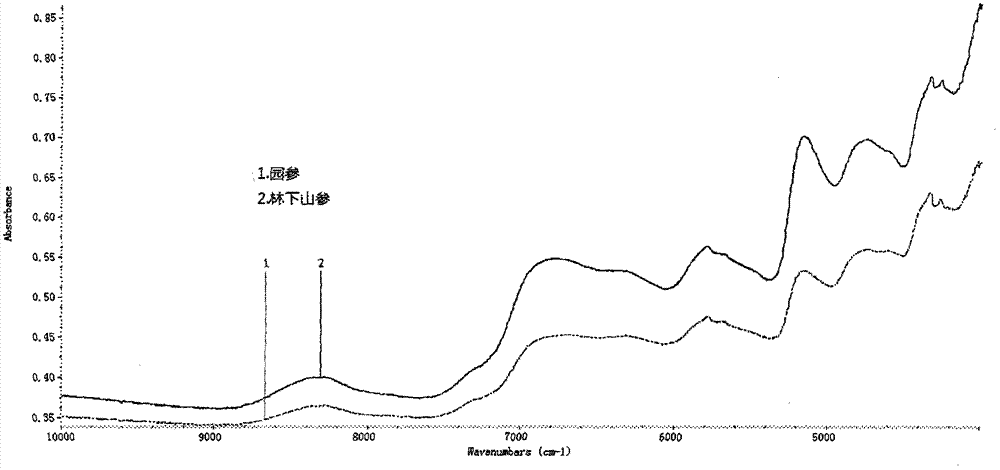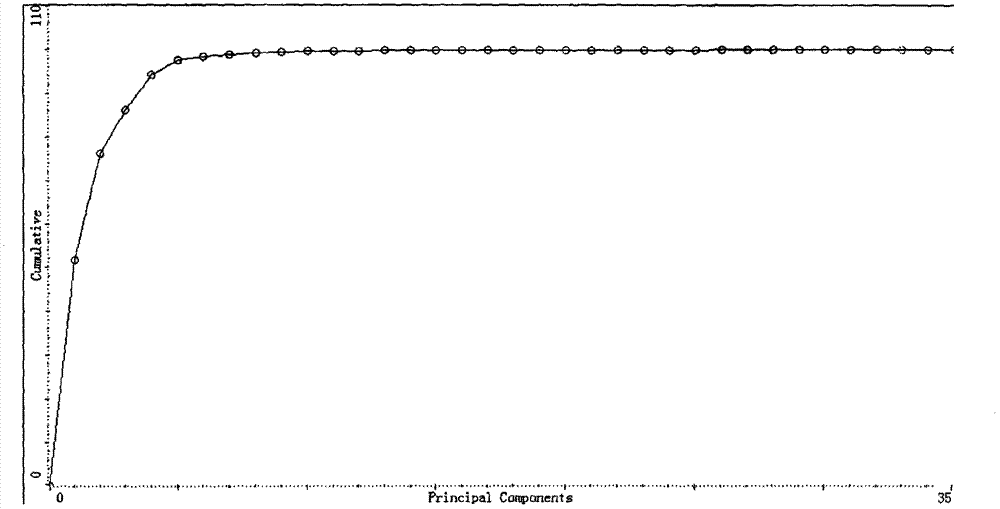Method for identifying ginsengs with different growth patterns by using near infrared spectrum technology and determining content of components in ginsengs
A near-infrared spectrum and near-infrared technology, applied in the direction of removing certain component weighing, color/spectral characteristic measurement, and measuring devices, can solve the problems of non-destructive analysis, chemical reagent pollution, limitations, etc. Conducive to qualitative discriminant analysis, the effect of more information and complete information
- Summary
- Abstract
- Description
- Claims
- Application Information
AI Technical Summary
Problems solved by technology
Method used
Image
Examples
Embodiment 1
[0103] 1. The experiment uses Antaris Fourier transform near-infrared spectrometer (Thermo Nicolet Company of the United States, light source: halogen tungsten lamp, equipped with Result 3.0 software for spectrum acquisition, TQ Analyst7.2 software for spectrum analysis), equipped with InGaAs detector, Fiber optic accessories.
[0104] 2. Spectrum acquisition range is 10000-4000cm -1 , resolution 8cm -1 , the number of scans is 32 times. With the built-in background of the instrument as a reference, the optical fiber accessory is used to collect the spectrum of the reed head of the sample. figure 1 It is the near-infrared original spectrum of garden ginseng and forest ginseng.
[0105] 3. A total of 318 samples of garden ginseng were selected from Linxiashan, involving different origins and different growth years, see Table 10 for details
[0106] Table 10 Details of sources of wild ginseng and garden ginseng samples under the forest
[0107]
[0108] 4. Spectrum prep...
Embodiment 2
[0112] 1. The experiment uses Antaris Fourier transform near-infrared spectrometer (Thermo Nicolet Company of the United States, light source: halogen tungsten lamp, equipped with Result3.0 software for spectrum acquisition, TQ Analyst7.2 software for spectrum analysis), equipped with InGaAs detector , Fiber optic accessories.
[0113] 2. Spectrum acquisition range is 10000-4000cm -1 , resolution 8cm -1 , the number of scans is 32 times. With the built-in background of the instrument as a reference, the optical fiber accessory is used to collect the spectrum of the upper part of the main root of the sample. figure 1 It is the near-infrared original spectrum of garden ginseng and forest ginseng.
[0114] 3. A total of 318 samples of ginseng from Linxiashan were selected, involving different origins and different growth years, see Table 1 for details
[0115] 4. Spectrum preprocessing: choose the processing method of MSC+spectrum (no derivation)+SGs (SG smoothing) to identi...
Embodiment 3
[0119] 1. The experiment uses Antaris Fourier transform near-infrared spectrometer (Thermo Nicolet Company of the United States, light source: tungsten halogen lamp, equipped with Result3.0 software for spectrum acquisition, TQ Ahalyst7.2 software for spectrum analysis), equipped with InGaAs detector , Fiber optic accessories.
[0120] 2. Spectrum acquisition range is 10000-4000cm -1 , resolution 8cm -1 , the number of scans is 32 times. Using the built-in background of the instrument as a reference, the optical fiber accessory is used to collect the spectrum of the lower part of the main root of the sample. figure 1 It is the near-infrared original spectrum of garden ginseng and forest ginseng.
[0121] 3. A total of 318 samples of ginseng from Linxiashan were selected, involving different origins and different growth years, see Table 1 for details
[0122] 4. Spectrum preprocessing: choose the processing method of MSC+spectrum (no derivation)+SGs (SG smoothing) to ident...
PUM
 Login to View More
Login to View More Abstract
Description
Claims
Application Information
 Login to View More
Login to View More - R&D
- Intellectual Property
- Life Sciences
- Materials
- Tech Scout
- Unparalleled Data Quality
- Higher Quality Content
- 60% Fewer Hallucinations
Browse by: Latest US Patents, China's latest patents, Technical Efficacy Thesaurus, Application Domain, Technology Topic, Popular Technical Reports.
© 2025 PatSnap. All rights reserved.Legal|Privacy policy|Modern Slavery Act Transparency Statement|Sitemap|About US| Contact US: help@patsnap.com



